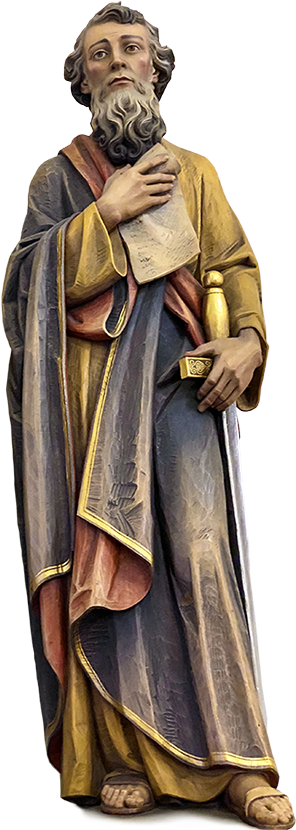Our PatronsNuestros Patrones

St. Peter
St. Peter, originally known as Simon, was a fisherman by trade. Jesus called Peter, along with his brother Andrew, James, and John, to leave everything behind to become His followers. Jesus said to them, “Come after me, and I will make you fishers of men.” (Matthew 4:19).
It is because of Peter’s confession of faith in Jesus as Messiah that Jesus gave him the nickname of “rock” and stated that it was upon the rock of Peter’s faith that the Church would rise (Matthew 16:18). All the Gospel writers list Peter first when naming the apostles of Jesus. Time and again in the Gospels, however, Peter demonstrates that his faith is imperfect, but growing.
He says things that make Jesus react strongly: he denies that Jesus’ coming death should ever be allowed to happen (Matthew 16:22), tells Jesus at the Last Supper that He will never wash his feet (John 13:8), and denies association with Jesus three times, even after Jesus predicted that he would do so. (Luke 22:61) St. Peter can show us how difficult discipleship can truly be but is also an example of the Lord choosing the weak and making them strong in bearing witness to Him. Peter was martyred (crucified upside down on a cross) for the Faith in the year 64 in Rome, the city he served as its first bishop.
St. Peter’s feast day is February 22nd, the feast of the primacy of St. Peter.

St. Paul
St. Paul’s background and journey of faith is somewhat different from St. Peter’s. Paul, who was originally known as Saul, was an educated Jew and a member of the Pharisee party, as well as being a Roman citizen. He first appears in the pages of Scripture in Acts 7:58, as being present at the martyrdom of St. Stephen, the first of Jesus’ followers to be put to death because of his faith in Jesus. Saul persecuted the Christians savagely but was dramatically converted to the very One he had been persecuting after seeing Jesus in a vision (Acts 9:4). From that time on, Saul, who was now known as Paul, poured the same energy with which he persecuted Christ’s followers into bringing the Gospel of Jesus to many people.
Paul traveled around most of what was the Roman Empire, establishing Christian communities. His many letters form the bulk of the writings of the New Testament. Paul was also martyred in Rome, three years after St. Peter, in the year 67 AD, by being beheaded (His Roman citizenship would not permit his being crucified). The feast commemorating his conversion is January 25th.
Peter and Paul represent two strikingly different approaches to discipleship. Peter had to learn slowly, make many mistakes along the way, but always experienced the compassionate forgiveness and encouragement of Jesus. Paul, on the other hand, came to the Faith immediately and never backed away from his zeal for Christ after that. Many of us can see both these great Apostles in ourselves. Like Peter, we sometimes fail yet persevere. Like Paul, we must always be on fire for the Lord, and proclaim Him to everyone and in every situation, no matter how difficult it can sometimes be to do so.
The feast day of St. Peter and St. Paul is celebrated on June 29th.

